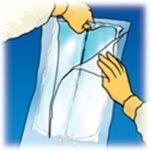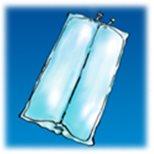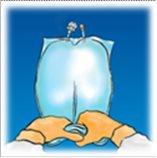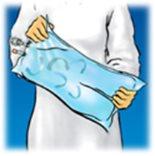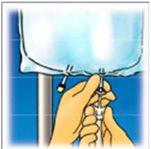
КЛІНІМІКС N12G20 РОЗЧИН ДЛЯ ІНФУЗІЙ
Запитайте лікаря про рецепт на КЛІНІМІКС N12G20 РОЗЧИН ДЛЯ ІНФУЗІЙ

Інструкція із застосування КЛІНІМІКС N12G20 РОЗЧИН ДЛЯ ІНФУЗІЙ
Введення
Опис: інформація для пацієнта
Clinimix N12G20 розчин для інфузії
Перед початком введення цього лікарського засобу прочитайте уважно весь опис, оскільки він містить важливу інформацію для вас.
- Збережіть цей опис, оскільки вам може знадобитися знову його прочитати.
- Якщо у вас виникли питання, проконсультуйтеся з вашим лікарем або медсестрою.
- Якщо ви відчуваєте побічні ефекти, проконсультуйтеся з вашим лікарем або медсестрою, навіть якщо ці побічні ефекти не вказані в цьому описі. Див. розділ 4.
Зміст опису:
- Що таке CLINIMIX і для чого він призначений
- Що потрібно знати перед початком введення CLINIMIX
- Як вводиться CLINIMIX
- Можливі побічні ефекти
- Зберігання CLINIMIX
- Зміст упаковки та додаткова інформація
1. Що таке Clinimix і для чого він використовується
CLINIMIX - це розчин для інфузії. Він поставляється в мішці з 2 відділеннями. Одне відділення містить розчин амінокислот, а друге - розчин глюкози. Відділення розділені тимчасовим герметиком. Зміст відділень потрібно змішати негайно перед введенням, скрутивши верхню частину мішка для відкриття герметика.
CLINIMIX призначений для харчування дорослих і дітей через трубку, підключену до вени, коли звичайне харчування через рот не є достатнім.
CLINIMIX повинен вводитися тільки під медичним наглядом.
2. Що потрібно знати перед початком введення Clinimix
CLINIMIX не повинен вводитися, якщо:
- ви алергічний на активні речовини або будь-які інші компоненти цього лікарського засобу (перелічені в розділі 6),
- ваш організм має проблеми з використанням деяких амінокислот,
- у вас надто високий рівень цукру в крові (важка гіперглікемія),
- ваша кров надто кисла (метаболічний ацидоз через надмірну кількість лактату),
У всіх випадках ваш лікар вирішить, чи слід вводити цей лікарський засіб, в залежності від таких факторів, як вік, вага та клінічний стан, разом з результатами всіх проведених досліджень.
Попередження та застереження
Проконсультуйтеся з вашим лікарем або медсестрою перед тим, як вони введуть CLINIMIX.
Якщо розвивається будь-який ненормальний знак або симптоми алергічної реакції, такі як гарячка, озноб, висипання на шкірі або труднощі з диханням, надмірне потіння, нудота і головний біль, повідомте про це вашому лікарю або медсестрі: інфузія буде негайно зупинена. Ваш лікар буде наглядати за вашим станом під час введення цього лікарського засобу і може змінити дозу або додати інші харчові речовини, такі як ліпіди, вітаміни, електроліти та олігоелементи, якщо це буде вважатися доцільним.
Деякі лікарські засоби та захворювання можуть збільшити ризик розвитку інфекції або сепсису (бактерії в крові). Існує особливий ризик інфекції або сепсису, коли в вашу вену вставляється трубка (інтравенозний катетер). Ваш лікар буде наглядати за вами, щоб виявити будь-які ознаки інфекції. Використання асептичних технік (вільних від мікробів) під час встановлення та утримання катетера та під час підготовки харчової формули може зменшити ризик інфекції.
Якщо ви важко недоношені і потребуєте харчування через вену, рекомендується починати батьківське харчування повільно та обережно.
Ваш лікар буде наглядати за вашим станом на початку інфузії, особливо якщо ви зараз страждаєте на захворювання печінки, нирок, наднирників, серця або судин. Ваш лікар також повинен бути обізнаний про важкі захворювання, які впливають на те, як організм використовує цукри, жири, білки чи солі (метаболічні розлади). Якщо розвивається будь-який ненормальний знак, включаючи венозний подразнення, інфузію потрібно зупинити.
Для перевірки ефективності та безпеки введення ваш лікар буде проводити лабораторні та клінічні дослідження під час введення цього лікарського засобу. Якщо вам вводять цей лікарський засіб протягом кількох тижнів, ваша кров буде регулярно аналізуватися. Особливо у разі непереносимості глюкози, рівень глюкози в крові та сечі буде регулярно контролюватися, а якщо ви пацієнт з цукровим діабетом, доза інсуліну може потребувати корекції.
Діти та підлітки
Коли використовується в новонароджених та дітей молодших 2 років, розчин (у мішках та обладнанні для введення) повинен бути захищений від світла до закінчення введення. Виставлення Clinimix світлу, особливо після змішування з олігоелементами та/або вітамінами, призводить до утворення пероксидів та інших продуктів розкладу, які можуть бути зменшені шляхом захисту від світла.
Взаємодія CLINIMIX з іншими лікарськими засобами
Повідомте вашому лікарю або медсестрі, якщо ви приймаєте або нещодавно приймали інші лікарські засоби чи можете приймати їх.
Вагітність, лактація та фертильність
Якщо ви вагітні або перебуваєте в період лактації, чи думаєте, що можете бути вагітні чи маєте намір завагітніти, проконсультуйтеся з вашим лікарем перед використанням цього лікарського засобу.
3. Як вводиться Clinimix
Перед введенням продукту потрібно розірвати тимчасовий герметик між двома відділеннями та змішати вміст обох.
CLINIMIX можна вводити дорослим та дітям.
Коли використовується в дітей молодших 2 років, розчин (у мішках та обладнанні для введення) повинен бути захищений від світла до закінчення введення (див. розділ 2).
Це розчин для інфузії, який вводиться через пластикову трубку, підключену до вени вашої руки або великої вени вашого грудного відділу.
Доза - дорослі та діти
Ваш лікар вирішить, яку дозу вам потрібно та протягом якого часу її потрібно вводити, в залежності від віку, ваги, зросту, клінічного стану, добової кількості рідини та потреб у енергії та нітрогені.
Слідуйте точно інструкціям щодо введення CLINIMIX, вказаним вашим лікарем. Проконсультуйтеся з вашим лікарем, якщо у вас виникли питання.
Введення може тривати протягом так довго, як це необхідно, в залежності від вашого клінічного стану.
Інфузія однієї мішки зазвичай триває від 8 до 24 годин.
Якщо вам введено більше CLINIMIX, ніж потрібно
Якщо введена доза надто висока або інфузія надто швидка, це може призвести до збільшення об'єму циркулюючої крові або до того, що кров стане надто кислою. Вміст глюкози може збільшити рівень глюкози в крові та сечі. Введення надмірного об'єму може спричинити нудоту, блювоту, тремор та порушення електролітного балансу. У цих ситуаціях інфузію потрібно негайно зупинити.
У деяких важких випадках ваш лікар може вирішити провести тимчасову діалізну терапію для допомоги вашим ниркам у видаленні надмірної кількості продукту.
Для уникнення цих випадків ваш лікар буде регулярно наглядати за вашим станом та аналізувати ваші параметри крові.
Якщо у вас виникли інші питання щодо використання цього продукту, проконсультуйтеся з вашим лікарем.
4. Можливі побічні ефекти
Як і всі лікарські засоби, цей лікарський засіб може спричинити побічні ефекти, хоча не всі люди їх відчувають. Якщо ви помітили будь-які зміни в вашому самопочутті під час лікування або після нього, негайно повідомте про це вашому лікарю або медсестрі.
Дослідження, які ваш лікар буде проводити під час введення цього лікарського засобу, повинні мінімізувати ризик побічних ефектів.
Інфузію потрібно негайно зупинити, якщо розвивається будь-який ненормальний знак або симптоми алергічної реакції, такі як аномально висока або низька артеріальна кров'яний тиск, появлення синього або фіолетового забарвлення шкіри, аномально висока частота серцевих скорочень, труднощі з диханням, блювота, нудота, висипання на шкірі, підвищення температури тіла, надмірне потіння та озноб.
Було спостережено інші побічні ефекти, які трапляються з більшою або меншою частотою:
- Анафілаксія (важка алергічна реакція, яка може призвести до смерті).
- Високі рівні глюкози, амонію та сполук, які містять нітроген, в крові.
- Погіршення функції печінки, аномальні показники функції печінки в аналізі крові.
- Запалення жовчного міхура, наявність каменів у жовчному міхурі.
- Запалення вен на місці інфузії, подразнення вен, біль, подразнення, печія, набряк.
- Наявність глюкози в сечі.
- Діабетична кома
- Формування малих частинок, які блокують легеневі кров'яні судини.
Повідомлення про побічні ефекти:
Якщо ви відчуваєте будь-які побічні ефекти, проконсультуйтеся з вашим лікарем або медсестрою, навіть якщо ці побічні ефекти не вказані в цьому описі. Ви також можете повідомити про них безпосередньо через систему моніторингу лікарських засобів: https://www.notificaram.es. Повідомляючи про побічні ефекти, ви можете допомогти надати більше інформації про безпеку цього лікарського засобу.
5. Зберігання Clinimix
Тримайте цей лікарський засіб поза зоною досяжності дітей.
Коли використовується в новонароджених та дітей молодших 2 років, розчин (у мішках та обладнанні для введення) повинен бути захищений від світла до закінчення введення (див. розділ 2).
Не використовуйте цей лікарський засіб після закінчення терміну придатності, вказаного на упаковці та зовнішній упаковці (ММ/РРРР). Термін придатності - останній день місяця, вказаного на упаковці.
Не заморожуйте.
Зберігайте упаковку у зовнішній упаковці.
Не викидайте лікарські засоби у водопровідні труби чи сміття. Якщо у вас виникли питання щодо утилізації упаковок та лікарських засобів, які вам не потрібні, проконсультуйтеся з вашим фармацевтом. Таким чином, ви допоможете захистити навколишнє середовище.
6. Зміст упаковки та додаткова інформація
Склад Клініміксу
Активні речовини кожної сумки реконституованого розчину:
Активні речовини | 1 л | 1,5 л | 2 л |
Л-Аланін | 7,25 г | 10,87 г | 14,49 г |
Л-Аргінін | 4,03 г | 6,04 г | 8,05 г |
Гліцин | 3,61 г | 5,41 г | 7,21 г |
Л-Гістидин | 1,68 г | 2,52 г | 3,36 г |
Л-Ізолейцин | 2,10 г | 3,15 г | 4,20 г |
Л-Лейцин | 2,56 г | 3,83 г | 5,11 г |
Л-Лізин (у вигляді гідрохлориду лізину) | 2,03 г (2,54 г) | 3,05 г (3,80 г) | 4,06 г (5,07 г) |
Л-Метіонін | 1,40 г | 2,10 г | 2,80 г |
Л-Фенілаланін | 1,96 г | 2,94 г | 3,92 г |
Л-Пролін | 2,38 г | 3,57 г | 4,76 г |
Л-Серін | 1,75 г | 2,63 г | 3,50 г |
Л-Треонін | 1,47 г | 2,21 г | 2,94 г |
Л-Триптофан | 0,63 г | 0,95 г | 1,26 г |
Л-Тирозин | 0,14 г | 0,21 г | 0,28 г |
Л-Валін | 2,03 г | 3,05 г | 4,06 г |
Анігдрит глюкози (у вигляді глюкози моногідрату) | 100 г (110 г) | 150 г (165 г) | 200 г (220 г) |
Інші компоненти:
- оцтова кислота, хлоридна кислота (для регулювання pH розчину),
- вода для ін'єкцій.
Вигляд Клініміксу та вміст упаковки
Клінімікс - це розчин для перфузії, який поставляється в багатошаровий пластиковий мішок з двома камерами. Матеріал внутрішнього шару (контактного) мішка виготовлений з полімерів (суміші кополімерів поліолефінів) для сумісності з компонентами та дозволеними добавками. Інші шари виготовлені з ЕВА (поліетилenu-вініл-ацетату) та кополіестеру.
До реконституції розчини глюкози та амінокислот прозорі, безколірні або легенько жовтуваті. Після реконституції розчин також прозорий, безколірний або легенько жовтуватий.
Для уникнення контакту з повітряним киснем мішок упакований всередині зовнішньої сумки, яка діє як бар'єр проти кисню, що містить абсорбент кисню.
Розміри упаковки
Мішок об'ємом 1000 мл: картонна коробка з 8 мішками
1 мішок об'ємом 1000 мл
Мішок об'ємом 1500 мл: картонна коробка з 6 мішками
1 мішок об'ємом 1500 мл
Мішок об'ємом 2000 мл: картонна коробка з 4 мішками
1 мішок об'ємом 2000 мл
Можливо, що тільки деякі розміри упаковки будуть реалізовані.
Уповноважений на реєстрацію
Baxter S.L.
Pouet de Camilo 2,
46394 Ribarroja del Turia (Valencia) Іспанія
Виробник
Baxter SA, Boulevard René Branquart, 80, 7860 Lessines, Бельгія
Цей лікарський засіб зареєстрований в країнах-членах Європейського економічного простору під наступними назвами:
Clinimix N12G20, розчин для перфузії
Останнє оновлення цієї інструкції було у вересні 2021 року
Детальна інформація про цей лікарський засіб доступна на сайті Іспанського агентства з лікарських засобів та медичних продуктів (AEMPS) http://www.aemps.gob.es/
-------------------------------------------------------------------------------------------------------------------
Ця інформація призначена лише для медичних працівників:
- Кількісний склад
Після змішування вмісту двох відділів склад суміші для всіх розмірів мішків забезпечує наступне:
1 л | 1,5 л | 2 л | |
Азот (г) Амінокислоти (г) Глюкоза (г) | 5,8 35 100 | 8,7 53 150 | 11,6 70 200 |
Загальна кількість калорій (ккал) Калорії глюкози (ккал) | 540 400 | 810 600 | 1080 800 |
Ацетат (ммоль) Хлорид (ммоль) | 27 15 | 41 22 | 54 29 |
pH Осмолярність (мОсм/л) | 6 920 |
- Дозування та спосіб введення.
Перед введенням продукту необхідно зламати непостійний затвор між двома відділами та змішати вміст обох.
Дозування та швидкість перфузії
Дозування повинно бути індивідуалізованим залежно від харчових потреб пацієнта, енергетичних витрат, клінічного стану, маси тіла та здатності метаболізувати компоненти Клініміксу, а також енергії чи білків, які вводяться додатково через рот/ентерально. Крім того, добові потреби рідини, азоту та енергії поступово зменшуються з віком.
У дорослих осіб потреби коливаються від 0,16 г азоту/кг/добу (приблизно 1 г амінокислот/кг/добу) до 0,32 г азоту/кг/добу (приблизно 2 г амінокислот/кг/добу).
У новонароджених потреби коливаються від 0,16 г азоту/кг/добу (приблизно 1 г амінокислот/кг/добу) до 0,40 г азоту/кг/добу (приблизно 2,5 г амінокислот/кг/добу).
У дорослих осіб та пацієнтів у віці від 12 до 18 років потреби калорій коливаються від 25 ккал/кг/добу до 40 ккал/кг/добу, залежно від стану харчування пацієнта та рівня катаболізму. Пацієнти молодше 12 років можуть мати вищі потреби.
Можуть бути клінічні ситуації, коли пацієнти потребують кількості харчових речовин, які відрізняються від складу Клініміксу. У这种 ситуації будь-яка корекція об'єму (дозування) повинна враховувати результат, який вона матиме на дозування всіх інших харчових компонентів Клініміксу. Швидкість та об'єм перфузії повинні встановлюватися лікарем з досвідом у сфері внутрішньовенної терапії у дітей.
Цей лікарський засіб не містить амінокислот цистеїн та таврін, які вважаються умовно необхідними для новонароджених та дітей.
Цей лікарський засіб не рекомендується для передчасних новонароджених, новонароджених у термін та дітей молодше 2 років.
Швидкість введення повинна коригуватися залежно від дозування, характеристик перфундуючої рідини, загальної кількості рідини за 24 години та тривалості перфузії.
Тривалість перфузії повинна бути більшою за 8 годин. Зазвичай швидкість введення збільшується поступово протягом першої години без перевищення 2,5 мл на кілограм маси тіла на годину, а максимальна доза становить 40 мл на кілограм маси тіла на добу.
Спосіб введення
Коли використовується у новонароджених та дітей молодше 2 років, сумку (у мішках та обладнанні для введення) слід захищати від світла до закінчення введення.
Шлях введення
Вводиться внутрішньовенно периферично або центрально залежно від кінцевої осмолярності суміші. Загалом прийнятий ліміт для периферичної перфузії становить близько 800 мОсм/л, але значно варіюється залежно від віку, загального стану пацієнта та характеристик периферичних вен.
- Спеціальні попередження та обережність під час застосування
Попередження
З використанням формул Клініміксу повідомлялося про реакції гіперчутливості/перфузії, включаючи гіпотонію, гіпертонію, периферичну ціаноз, тахікардію, задиху, блювання, нудоту, кропив'янку, висип, свербіж, еритему, гіпергідроз, гарячку та озноб.
З іншими продуктами батьківської харчування повідомлялося про анафілаксію.
При початку будь-якої внутрішньовенної перфузії необхідна спеціальна клінічна моніторинг. У разі появи будь-яких аномальних ознак чи симптомів, наприклад реакції гіперчутливості чи реакції на перфузію, слід негайно припинити перфузію.
Розчини, які містять глюкозу, слід використовувати з обережністю, у будь-якому випадку, у пацієнтів з відомою алергією до кукурудзи чи продуктів, одержаних з кукурудзи.
Повідомлялося про васкулярні пульмонарні осади у пацієнтів, які отримують батьківську харчування.
У деяких випадках це призвело до смертельних результатів. Надмірне додавання кальцію та фосфату збільшує ризик утворення осадів фосфату кальцію. Осади повідомлялися навіть у відсутності фосфатної солі у розчині. Також повідомлялося про дистальну осадження у фільтрі та підозрюється утворення осаду in vivo.
Якщо з'являються ознаки пульмональної недостатності, перфузію слід припинити та розпочати медичну оцінку.
Крім інспекції розчину, обладнання для інфузії та катетера також слід періодично перевіряти на наявність осадів.
Використання внутрішньовенних катетерів для введення батьківських формул може привести до інфекції та сепсису.
Імунносупресія та інші чинники, такі як гіперглікемія, недоїдання та/або основне захворювання, можуть схилити пацієнтів до інфекційних ускладнень.
Симптоматичне лікування та лабораторний контроль температури/ознобу, лейкоцитозу, технічних ускладнень з пристроєм доступу та гіперглікемії можуть допомогти виявити інфекції на ранній стадії.
Поширення септичних ускладнень можна зменшити, надавши більшу увагу застосуванню асептичної техніки при встановленні катетера, його обслуговуванні та підготовці харчової формули.
Переходження пацієнтів з тяжкою недоїданням до харчування може призвести до синдрому переїдання, який характеризується зміною потасію, фосфору та магнію всередині клітини, оскільки пацієнт перебуває в анаболічному стані. Також можуть з'явитися дефіцит тіаміну та затримка рідини. Строгий контроль та поступове введення харчових речовин, уникнення переїдання можуть запобігти цим ускладненням.
Гіпертонічні розчини можуть викликати венозну іритацію, якщо їх перфундувати через периферичну вену. Вибір периферичної або центральної вени залежить від кінцевої осмолярності суміші.
Загально прийнятий ліміт для периферичної перфузії становить близько 800 мОсм/л, але значно варіюється залежно від віку та загального стану пацієнта та характеристик периферичних вен.
Не слід підключати послідовно пластикові контейнери, щоб уникнути повітряних емболій через можливий залишковий повітря у первинному контейнері.
Обережність
Перед початком перфузії слід виправити тяжкі порушення водно-електролітного балансу, тяжкі стани переобволоження рідини та тяжкі метаболічні розлади.
Можуть виникнути метаболічні ускладнення, якщо споживання харчових речовин не відповідає потребам пацієнта чи якщо метаболічна здатність будь-якого харчового компонента не оцінюється точно. Можуть виникнути несприятливі метаболічні ефекти через неправильне або надмірне введення харчових речовин чи через склад суміші, який не підходить для конкретних потреб пацієнта.
Необхідно проводити клінічні оцінки та лабораторні визначення з частою періодичністю для правильного контролю під час введення. Це включатиме визначення іонограми та функціональних проб нирок та печінки.
Необхідно визначати та контролювати ретельно електролітні потреби пацієнтів, які отримують ці розчини, особливо у разі розчинів без електролітів.
Нетолерантність до глюкози є поширеним метаболічним ускладненням у пацієнтів, які перебувають під сильним стресом. Перфузія цього розчину може призвести до гіперглікемії, глюкозурії та гіперосмолярного синдрому. Цукор у крові та сечі слід контролювати регулярно та, якщо необхідно, для діабетиків слід коригувати дозу інсуліну.
Відповідально застосовувати у пацієнтів з нирковою недостатністю, особливо якщо є гіперкаліємія, через ризик появи чи погіршення метаболічного ацидозу та гіперазотемії, якщо не проводиться позаниркова елімінація відходів. Стан рідини та електролітів слід контролювати ретельно у цих пацієнтів. У разі тяжкої ниркової недостатності слід вибирати спеціально розроблені розчини амінокислот.
Слід бути обережним при введенні Клініміксу пацієнтам з наднирковою недостатністю.
Слід уникати переобволоження, особливо у пацієнтів з пульмонним едемом, нирковою недостатністю та/або серцевою недостатністю. Стан рідини слід контролювати ретельно.
Крім регулярних проб печінкової функції, у пацієнтів з попередньо існуючою печінковою недостатністю або захворюванням печінки слід контролювати можливі симптоми гіперамонемії.
Відомо, що у деяких пацієнтів з батьківською харчуванням з'являються печінково-жовчові розлади, включаючи холестаз, стеатоз печінки, фіброз та цироз, які можуть призвести до печінкової недостатності, а також холецистит та холелітіаз. Гіпотезується, що етіологія цих розладів є багатофакторною та може відрізнятися між пацієнтами. Тих, хто розвиває аномальні лабораторні параметри чи інші ознаки печінково-жовчових розладів, слід швидко оцінювати клінічним експертом з захворювань печінки для визначення можливих причинних та внесених чинників, а також можливих терапевтичних та профілактичних заходів.
У пацієнтів, які отримують розчини амінокислот, може відбуватися збільшення рівня амонію в крові та гіперамонемія. У деяких пацієнтів це може вказувати на наявність вроджених розладів метаболізму амінокислот (див. розділ 4.3 характеристики лікарського засобу) або печінкової недостатності.
Слід часто вимірювати амоній у крові у новонароджених та дітей для виявлення гіперамонемії, яка може вказувати на наявність вродженої аномалії метаболізму амінокислот.
Залежно від ступеня та етіології гіперамонемія може потребувати негайного втручання.
Перфузія амінокислот занадто швидко може призвести до нудоти, блювання та ознобу. У цих випадках слід негайно припинити перфузію.
Загалом дозування для пацієнтів похилого віку повинно бути обережним, враховуючи більшу частоту печінкової, ниркової чи серцевої недостатності та супутніх захворювань чи фармакотерапії.
Педіатричне населення
- Не проводилися дослідження на педіатричному населенні.
- Див. вище щодо моніторингу гіперамонемії у педіатичних пацієнтів.
Експозиція світлу розчинів для батьківської харчування через внутрішньовенне введення, особливо після змішування з олігоелементами чи вітамінами, може мати несприятливі ефекти на клінічний результат у новонароджених через утворення пероксидів та інших продуктів розкладу. Коли використовується у новонароджених та дітей молодше 2 років, Клінімікс слід захищати від світла до закінчення введення.
- Практична інформація про підготовку та обробку
Обережність: Вводіть продукт лише після порушення печатки та змішування вмісту двох відділів
1. |
| 2. |
| 3. |
|
Відкрийте зверху, щоб відкрити зовнішній пакет. | Видаліть передню частину зовнішнього пакету, щоб дістатися до мішка Клініміксу. Витратьте зовнішній пакет та пакет з абсорбентом кисню. | Помістіть мішок на горизонтальну та чисту поверхню з ручкою попереду. | |||
4. |
| 5. |
| 6. |
|
Підніміть зону підвісу, щоб вийняти розчин з верхньої частини мішка. Прокатайте мішок тісно, поки не відкриється повністю печатка (приблизно до половини). | Змішайте вміст, перевернувши мішок至少 3 рази. | Підвісьте мішок. Поверніть захисник, щоб вийняти його з місця введення. Підключіть з'єднувач щільно. |
Використовуйте розчин лише якщо він прозорий, безколірний або легенько жовтуватий, та якщо упаковка не пошкоджена.
Клінімікс повинен бути при кімнатній температурі перед його застосуванням.
Активація Клініміксу може здійснюватися у зовнішньому пакеті чи після його видалення.
Для одного застосування.
Не зберігайте частково використані пакети та викидайте все обладнання після використання.
Не підключайте частково використаний мішок знову.
Не підключайте послідовно.
Коли використовується у новонароджених та дітей молодше 2 років, слід захищати від світла до закінчення введення. Експозиція Клініміксу до світла, особливо після змішування з олігоелементами чи вітамінами, генерує пероксиди та інші продукти розкладу, які можуть зменшитися, якщо захищати продукт від світла.
Додаткове харчування
Пацієнтам, які отримують батьківське харчування тривалий період, слід забезпечувати ліпіди, вітаміни та олігоелементи.
Якщо необхідно введення...
Від додавання добавок слід перевіряти сумісність та контролювати стабільність сумішей.
Доповнення можна проводити після відкриття не постійних печаток для всіх добавок (після змішування двох розчинів). CLINIMIX можна доповнювати:
- Ліпідними емульсіями (наприклад ClinOleic) зі швидкістю 50-250 мл на літр CLINIMIX
CLINIMIX N12G20 1 л + 100 мл Ліпідів 20% | CLINIMIX N12G20 1,5 л + 250 мл Ліпідів 20% | CLINIMIX N12G20 2 л + 250 мл ліпідів 20% | |
Азот (г) Амінокислоти (г) Глюкоза (г) Ліпіди (г) | 5,8 35 100 20 | 8,7 53 150 50 | 11,6 70 200 50 |
Всього калорій (ккал) Калорії глюкози (ккал) Ліпідні калорії (ккал) Відношення глюкози/ліпідів | 740 400 200 67/33 | 1310 600 500 55/45 | 1580 800 500 62/38 |
Ацетат (ммоль) Хлорид (ммоль) | 27 15 | 41 22 | 54 29 |
pH Осмолярність (мОсм/л) | 6 860 | 6 830 | 6 850 |
- Електроліти: на літр CLINIMIX
До кінцевої концентрації | Натрій | Калій | Магній | Кальцій |
80 ммоль | 60 ммоль | 5,6 ммоль | 3,0 ммоль |
- Олігоелементи: на літр CLINIMIX
До кінцевої концентрації | Мідь | 10 мкмоль | Цинк | 77 мкмоль |
Хром | 0,14 мкмоль | Манган | 2,5 мкмоль | |
Фтор | 38 мкмоль | Кобальт | 0,0125 мкмоль | |
Селен | 0,44 мкмоль | Молібден | 0,13 мкмоль | |
Йод | 0,5 мкмоль | Залізо | 10 мкмоль |
- Вітаміни: на літр CLINIMIX
До кінцевої концентрації | Вітамін А | 1750 ОД | Біотин | 35 мкг |
Вітамін В6 | 2,27 мг | Вітамін В1 | 1,76 мг | |
Вітамін Д | 110 ОД | Фолієва кислота | 207 мкг | |
Вітамін В12 | 3,0 мкг | Вітамін В2 | 2,07 мг | |
Вітамін Е | 5,1 мг | Вітамін С | 63 мг | |
Вітамін РР | 23 мг | Вітамін В5 | 8,63 мг | |
Вітамін К | 75 мкг |
Дані про стабільність для доповнення CLINIMIX іншими ліпідними емульсіями та іншими добавками чи нутрієнтами доступні за запитом.
Якщо спостерігається утворення легкої креми, суміш слід повністю перемішати шляхом легкого
встряхування для отримання однорідної емульсії перед перфузією.
Доповнення повинні проводитися в асептичних умовах.
Доповнення можуть проводитися за допомогою шприца або обладнання для перекачування.
- Доповнення за допомогою шприца або обладнання для перекачування з голкою.
- Підготувати місце введення (один туб, див. рисунок 1).
- Прокол тубу та введення.
- Перемішування розчину та добавок.
Несумісності
Додатки можуть бути несумісними, зверніться до виробника за додатковою інформацією.
Якщо необхідно додавати додатки, слід перевіряти сумісність та контролювати стабільність сумішей.
Розчин не слід вводити з, до або після введення крові через те саме обладнання, зважаючи на можливість псевдоаглютинації.
Як і з будь-якою сумішшю парентерального харчування, слід враховувати пропорції кальцію та фосфату. Додавання надмірної кількості кальцію та фосфату, особливо у вигляді мінеральних солей, може призвести до утворення осадів фосфату кальцію.
- Строк придатності
2 роки, якщо зберігати в суперболі.
Рекомендується використовувати продукт негайно після відкриття не постійного печатка між двома камерами. Однак після реконструкції (тобто після відкриття внутрішнього не постійного печатка) було доведено стабільність реконструйованого розчину протягом максимум 7 днів при температурі між 2 °C та 8 °C, а потім протягом максимум 48 годин при температурі, що не перевищує 25 °C.
З мікробіологічної точки зору суміші слід використовувати негайно після проведення добавок. Якщо вони не використовуються негайно, час зберігання в користуванні та умови перед використанням є відповідальністю користувача і не повинні перевищувати 24 години при 2-8 °C, якщо додавання не проводилися в контрольованих та валідованих асептичних умовах. Якщо потрібні триваліші терміни зберігання в особливих умовах, можна зв'язатися з компанією, оскільки вона володіє даними про фізичну та хімічну стабільність в користуванні протягом 7 днів при 2-8 °C, а потім протягом 48 годин при температурі нижче 25 °C для продуктів, вказаних у попередньому розділі.
- Країна реєстрації
- Діючі речовини
- Потрібен рецептТак
- Виробник
- Інформація є довідковою і не є медичною порадою. Перед прийомом будь-яких препаратів обов'язково проконсультуйтеся з лікарем. Oladoctor не несе відповідальності за медичні рішення, прийняті на основі цього контенту.
- Альтернативи до КЛІНІМІКС N12G20 РОЗЧИН ДЛЯ ІНФУЗІЙФорма випуску: ІН'ЄКЦІЙНИЙ РОЗЧИН ДЛЯ ІНФУЗІЙ, 3,5 г / 200 г / 5,22 г / 1,88 г / 3,92 г / 1,26 г / 7,21 г / 3,36 г / 4,2 г / 5,11 г / 2,94 г / 2,8 г / 662 мг / 1,02 г / 4,76 г / 5,15 г / 5,07 г / 4,06 г / 14,49 г / 0,28 г / 8,05 гДіючі речовини: combinationsВиробник: Baxter S.L.Потрібен рецептФорма випуску: ІН'ЄКЦІЙНИЙ РОЗЧИН ДЛЯ ІНФУЗІЙ, 4,25 г / 300 г / 5,22 г / 1,54 г / 4,76 г / 1,53 г / 8,76 г / 4,08 г / 5,1 г / 6,2 г / 3,57 г / 3,4 г / 662 мг / 1,02 г / 5,78 г / 5,94 г / 6,16 г / 4,93 г / 17,6 г / 0,34 г / 9,78 гДіючі речовини: combinationsВиробник: Baxter S.L.Потрібен рецептФорма випуску: РОЗЧИН ДЛЯ ІНФУЗІЙ, ЩО ВВОДИТЬСЯ ІН'ЄКЦІЙНО, 2,75 г / 150 г / 5,22 г / 2,24 г / 3,08 г / 0,99 г / 5,66 г / 2,64 г / 3,3 г / 4,02 г / 2,31 г / 2,2 г / 662 мг / 1,02 г / 3,74 г / 4,31 г / 4 г / 3,19 г / 11,38 г / 0,22 г / 6,32 гДіючі речовини: combinationsВиробник: Baxter S.L.Потрібен рецепт
Аналоги КЛІНІМІКС N12G20 РОЗЧИН ДЛЯ ІНФУЗІЙ в інших країнах
Найкращі аналоги з тією самою діючою речовиною та терапевтичним ефектом.
Аналог КЛІНІМІКС N12G20 РОЗЧИН ДЛЯ ІНФУЗІЙ у Польща
Аналог КЛІНІМІКС N12G20 РОЗЧИН ДЛЯ ІНФУЗІЙ у Україна
Лікарі онлайн щодо КЛІНІМІКС N12G20 РОЗЧИН ДЛЯ ІНФУЗІЙ
Консультація щодо дозування, побічних ефектів, взаємодій, протипоказань та поновлення рецепта на КЛІНІМІКС N12G20 РОЗЧИН ДЛЯ ІНФУЗІЙ – за рішенням лікаря та згідно з місцевими правилами.





